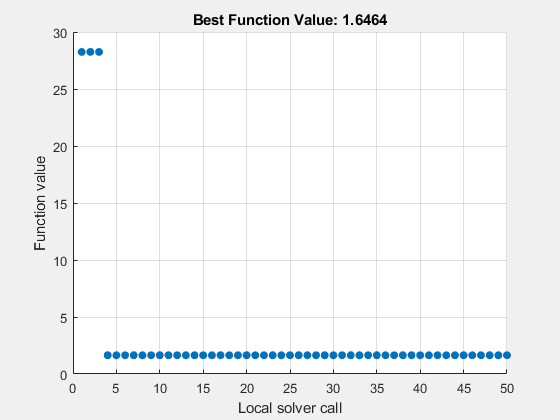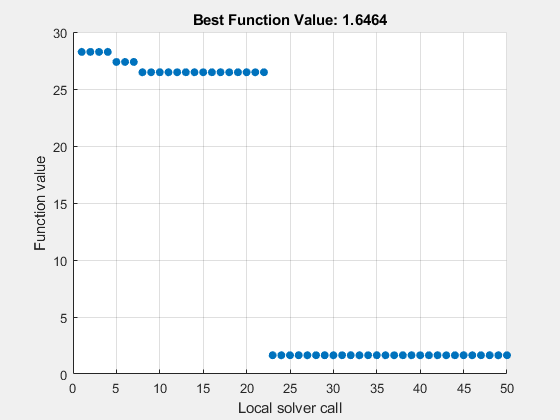使用 lsqcurvefit 或 lsqnonlin 的 MultiStart
此示例显示如何使用 lsqcurvefit 和 MultiStart 来使函数适合数据。示例的末尾展示了使用 lsqnonlin 的相同解。
许多拟合问题都有多个局部解。MultiStart 可以帮助找到全局解,即最佳拟合。本例首先使用 lsqcurvefit,因为它的语法很方便。
模型是
其中输入数据为 ,参数 、、、 为未知模型系数。
步骤 1.创建目标函数。
编写一个匿名函数,该函数接受具有 xdata 行和两列的数据矩阵 N,并返回具有 N 行的响应向量。该函数还采用系数矩阵 p,对应系数向量 。
fitfcn = @(p,xdata)p(1) + p(2)*xdata(:,1).*sin(p(3)*xdata(:,2)+p(4));
步骤 2.创建训练数据。
创建 200 个数据点和响应。使用值 。在响应中包含随机噪声。
rng default % For reproducibility N = 200; % Number of data points preal = [-3,1/4,1/2,1]; % Real coefficients xdata = 5*rand(N,2); % Data points ydata = fitfcn(preal,xdata) + 0.1*randn(N,1); % Response data with noise
步骤 3.设置边界和初始点。
为 lsqcurvefit 设置边界。 的绝对值没有理由超过 ,因为正弦函数在任何宽度区间 上都取其整个范围内的值。假设系数 的绝对值必须小于 20,因为允许高频率会导致不稳定的响应或不准确的收敛。
lb = [-Inf,-Inf,-20,-pi]; ub = [Inf,Inf,20,pi];
将初始点任意设置为 (5,5,5,0)。
p0 = 5*ones(1,4); % Arbitrary initial point p0(4) = 0; % Ensure the initial point satisfies the bounds
步骤 4.求最佳局部拟合。
将参数与数据拟合,从 p0 开始。
[xfitted,errorfitted] = lsqcurvefit(fitfcn,p0,xdata,ydata,lb,ub)
Local minimum possible. lsqcurvefit stopped because the final change in the sum of squares relative to its initial value is less than the value of the function tolerance. <stopping criteria details>
xfitted = 1×4
-2.6149 -0.0238 6.0191 -1.6998
errorfitted = 28.2524
lsqcurvefit 找到一个不是特别接近模型参数值 (-3,1/4,1/2,1) 的局部解。
步骤 5.为 MultiStart 设置问题。
创建一个问题结构体,以便 MultiStart 可以解决同样的问题。
problem = createOptimProblem('lsqcurvefit','x0',p0,'objective',fitfcn,... 'lb',lb,'ub',ub,'xdata',xdata,'ydata',ydata);
步骤 6.找到一个全局解。
使用 MultiStart 通过 50 次迭代解决拟合问题。将最小误差绘制为 MultiStart 迭代次数。
ms = MultiStart('PlotFcns',@gsplotbestf);
[xmulti,errormulti] = run(ms,problem,50)
MultiStart completed the runs from all start points. All 50 local solver runs converged with a positive local solver exitflag.
xmulti = 1×4
-2.9852 -0.2472 -0.4968 -1.0438
errormulti = 1.6464
MultiStart 在参数值 (-3,-1/4,-1/2,-1) 附近找到了一个全局解。(这相当于接近 preal = (-3,1/4,1/2,1)的解,因为改变除第一个系数之外的所有系数的符号都会得出相同的 fitfcn 数值。)残差误差的范数从约 28 减少至约 1.6,减少了 10 倍以上。
构建关于 lsqnonlin 的问题
作为替代方法,使用 lsqnonlin 作为拟合函数。在这种情况下,使用预测值和实际数据值之间的差异作为目标函数。
fitfcn2 = @(p)fitfcn(p,xdata)-ydata; [xlsqnonlin,errorlsqnonlin] = lsqnonlin(fitfcn2,p0,lb,ub)
Local minimum possible. lsqnonlin stopped because the final change in the sum of squares relative to its initial value is less than the value of the function tolerance. <stopping criteria details>
xlsqnonlin = 1×4
-2.6149 -0.0238 6.0191 -1.6998
errorlsqnonlin = 28.2524
从同一个初始点 p0 出发,lsqnonlin 和 lsqcurvefit 一样找到了相对较差的解。
使用 MultiStart 作为局部求解器运行 lsqnonlin。
problem2 = createOptimProblem('lsqnonlin','x0',p0,'objective',fitfcn2,... 'lb',lb,'ub',ub'); [xmultinonlin,errormultinonlin] = run(ms,problem2,50)

MultiStart completed the runs from all start points. All 50 local solver runs converged with a positive local solver exitflag.
xmultinonlin = 1×4
-2.9852 -0.2472 -0.4968 -1.0438
errormultinonlin = 1.6464
再次,MultiStart 找到了比单独使用局部求解器更好的解。